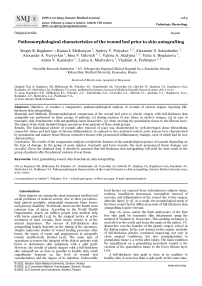Pathomorphological characteristics of the wound bed prior to skin autografting
Автор: Sergey B. Bogdanov, Karina I. Melkonyan, Andrey V. Polyakov, Alexander S. Sotnichenko, Alexander A. Veryovkin, Irina V. Gilevich, Valeria A. Aladyina, Yulia A. Bogdanova, Anton V. Karakulev, Larisa A. Medvedeva, Vladimir A. Porkhanov
Журнал: Saratov Medical Journal @sarmj
Статья в выпуске: 2 Vol.3, 2022 года.
Бесплатный доступ
Objective: to conduct a comparative pathomorphological analysis of wounds of various origins requiring full-thickness skin autografting. Materials and Methods. Histomorphological comparison of the wound bed prior to plastic surgery with full-thickness skin autografts was performed in three groups of patients: (1) during excision of scar tissue in elective surgery; (2) in case of traumatic skin detachments with autografting sensu Krasovitov; (3) when excising the granulation tissue to the fibrous layer. The object of the study included biopsy specimens from patients of three study groups. Results. The histological picture of wounds after removal of scars was characterized by well-developed dense fibrocellular connective tissue and had signs of chronic inflammation. In contrast to the cicatricial wound, acute lesions were characterized by granulation and mature dense fibrous connective tissues with pronounced inflammatory changes, each of which had its own characteristics. Conclusion. The results of the comparative analysis revealed the features of the morphological picture of wounds depending on the type of damage. In the group of acute injuries, traumatic and burn wounds, the most pronounced tissue damage was revealed. Given the obtained data, it should be assumed that full-thickness skin autografting will yield the best result in the group of patients after the planned excision of scar tissue.
Burn, granulating wound, skin detachment, skin autografting
Короткий адрес: https://sciup.org/149146149
IDR: 149146149 | DOI: 10.15275/sarmj.2022.0202
Список литературы Pathomorphological characteristics of the wound bed prior to skin autografting
- Salamone JC, Salamone AB Swindle-Reilly K, et al. Grand challenge in biomaterials: Wound healing. Regen Biomater 2016; 3: 127-8. https://doi.org/10.1093/rb/rbw015
- Andreev SV. Modeling of Diseases. Moscow: Medicine, 1973; 336 р. [In Russ].
- Shevchenko RV, James SE, Reed MJ, et al. Pig experimental model as an effective tool for transferring scientific knowledge to the clinic to replenish the arsenal of combustiologist. Combustiology 2007; 30. URL: http://combustiolog.ru/journal/svinaya-e-ksperimental-naya-model-kak-e-ffektivny-j-instrument-perenosa-nauchny-h-znanij-v-kliniku-dlya-popolneniya-arsenala-kombustiologa/ (15 Feb 2022). [In Russ].
- Burd A, Ahmed K, Lam S, et al. Stem cell strategies in burns care. Burns 2007; 33 (3): 282-91. https://doi.org/10.1016/j.burns.2006.08.031.
- Chua AWC, Khoo YC, Tan BK, et al. Skin tissue engineering advances in severe burns: Review and therapeutic applications. Burns Trauma 2016; 4 (1): 3. https://doi.org/10.1186/s41038-016-0027-y.
- Climov M, Medeiros E, Farkash EA, et al. Bioengineered self-assembled skin as an alternative to skin grafts. Plastic and Reconstructive Surgery Global Open 2016; 4 (6): e731. https://doi.org/10.1097/GOX.0000000000000723.
- Keck M, Haluza D, Lumenta DB, et al. Construction of a multi-layer skin substitute: Simultaneous cultivation of keratinocytes and preadipocytes on a dermal template. Burns 2011; 37 (4): 626-30. https://doi.org/10.1016/j.burns.2010.07.016.
- Leclerc T, Thepenier C, Jault P, et al. Cell therapy of burns. Cell Proliferation 2011; 44: 48-54. https://doi.org/10.1111/j.1365-2184.2010.00727.x.
- Wormald JC, Fishman JM, Juniat S. Regenerative medicine in otorhinolaryngology. J Laryngol Otol 2015; 129 (8): 732-9. https://doi.org/10.1017/S0022215115001577.
- Bogdanov SB, Gilevich IV, Fedorenko TV, et al. Possibilities of using cell therapy in skin plastic surgery. Innovative Medicine of Kuban 2018; 3: 16-21. [In Russ].
- Bogdanov SB, Kurinnyi NA, Polyakov AV, et al. Method of skin grafting after early necrectomy. Russian Federation Patent for Invention RU 2295924 C, 27 March 2007. Application No.2005123211 of 21 July 2005. [In Russ].
- Slavinsky AA, Veryovkin AA, Sotnichenko AS, et al. Immunohistochemical profile of a mononuclear infiltrate in the myocardium of a transplanted heart. Computer morphometry. Kuban Scientific Medical Bulletin 2020; 27 (2): 92-101. [In Russ]. https://doi.org/10.25207/1608-6228-2020-27-2-92-101.
- Grellner W, Madea B. Demands on scientific studies: Vitality of wounds and wound age estimation. Forensic Sci Int 2007; 165 (2-3): 150-4. https://doi.org/10.1016/j.forsciint.2006.05.029.
- Velnar T, Bailey T, Smrkolj V. The wound healing process: An overview of the cellular and molecular mechanisms. J Int Med Res 2009; 37: 1528-42. https://doi.org/10.1177/147323000903700531.
- Delavary BM, van der Veer WM, van Egmond M, et al. Macrophages in skin injury and repair. Immunobiology. Elsevier GmbH 2011; 216 (7): 753-62. https://doi.org/10.1016/j.imbio.2011.01.001.
- Demidova-Rice TN, Durham JT, Herman IM. Wound healing angiogenesis: Innovations and challenges in acute and chronic wound healing. Adv Wound Care 2012; (1): 17-22. https://doi.org/10.1089/wound.2011.0308.
- Pober JS, Tellides G. Participation of blood vessel cells in human adaptive immune responses. Trends Immunol 2012; (33): 49-57. https://doi.org/10.1016/j.it.2011.09.006.
- Landén NX, Li D, Ståhle M. Transition from inflammation to proliferation: A critical step during wound healing. Cell Mol Life Sci 2016; (73): 3861-85. https://doi.org/10.1007/s00018-016-2268-0.


